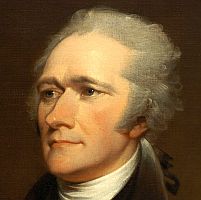 Alexander Hamilton suggested in The Federalist Papers that “a few armed vessels, judiciously stationed at the entrances of our ports, might at a small expense be made useful sentinels of the laws.”
Alexander Hamilton suggested in The Federalist Papers that “a few armed vessels, judiciously stationed at the entrances of our ports, might at a small expense be made useful sentinels of the laws.”
When Hamilton became the first Treasury Secretary of the newly formed United States, he lobbied for the acquisition of 10 revenue cutters to assist in the collection of duties and to catch smugglers. On August 4, 1790, 232 years ago today, President Washington signed a bill establishing the Revenue Cutter Service, the precursor to today’s United States Coast Guard. Alexander Hamilton is considered by many to be the father of the US Coast Guard. An updated repost.
William Thiesen, Historian, Coast Guard Atlantic Area, writes that “Hamilton also took a special interest in manning his fleet. The officers were responsible for enlisting each cutter’s crew, which consisted of a master; first, second and third mates; four enlisted men; and two boys. Hamilton thought it best to provide a large number of junior officers in case one or more had to ride an inbound merchant vessel to oversee the integrity of its cargo. To supplement their base salary and increase their zeal for the work, officers and crew received part of the proceeds derived from fines, penalties, and forfeitures collected from seizures of illegal cargo and smuggled goods.”
For several years, the Revenue Cutter Service would be the new republic’s only naval force. The Continental Navy had been disbanded and all the remaining ships sold in 1785. The Naval Act of 1794 authorized building six frigates for a navy that wouldn’t be created by Congress until April 1798.
